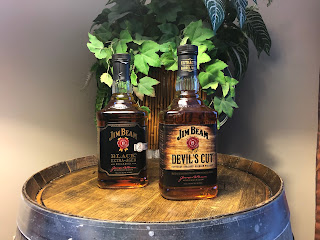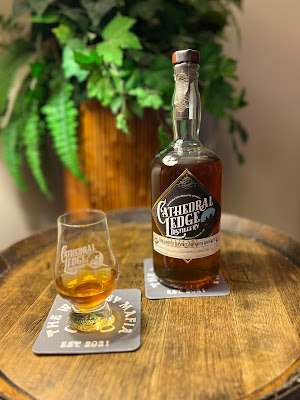Dan discovered Whiskey University in his quest to learn everything about his favorite spirit. In the process of learning more about the curriculum, he managed to get himself recruited as a future instructor in Maine. The first class happened to be a basic level tasting class on Jim Beam brands, and knowing that I was into Jim Beam, Dan invited me to join him.
Like most major distilleries, all of the dozens of major Jim Beam brands boil down to just a couple of mash bills: the Jim Beam low rye mash bill (75% Corn, 18% Rye, 12% Barley), and the Old Grand Dad mash bill (63% Corn, 27% Rye, 12% Barley). What separates most of the bourbons in these flights, then, boils down to how and where the whiskey was aged, and the proof of the spirit going into the barrel, and of course the bottled proof.
If I was expecting a "tasting" class to be about the sensory aspects of the dozen or so samples we were set to try, the actual experience of the class was much more focused on facts and history surrounding the three main lines in the Jim Beam product line, and, of course, their marketing.
The program started with an overview of Beam Suntory and the Bean Family's remarkable story beginning with Jacob Beam, the first Master Distiller, and leading up to James Beam, the current brand's namesake who re-established the family business at age 70, just 120 days after the end of Prohibition. From there, we proceeded to discuss that three main product lines that beam produces, and some of the key brands within those lines.
It was an interesting overview of the brands owned and marketed today by the worlds leading Bourbon whiskey distiller. Here's an overview of the presentation:
Jim Beam Family Flight
We began with The Jim Beam namesake brands. These are where the money is made, and the line includes Jim Beam white label, Black Label, and Devil's Cut as well as the flavored whiskey line that began with Red Stag.
 Jim Beam White Label -
Jim Beam White Label - We started with Jim Beam's flagship white label bourbon; the world's number one selling bourbon whiskey which gained its popularity in part because T. Jeremiah Beam made certain that every US Service Member in World War II had ready access to it. "Jere's" astute marketing set the tone for the constantly innovating brand that Jim Beam remains to this day.
Jim Beam Devil's Cut - I have to admit that I had always considered Devil's Cut to me more gimmick than innovation, but for me Devil's Cut had the most distinctive and unique flavor in the flight and is worth sampling if you've never tried it. As much as 20% of the bourbon in a bottle of Devil's cut is extracted from the walls of the barrel through a patented process.
Jim Beam Black - The Black Label product was introduced in the 70's and is aged longer than the white label. Jim Beam Black stood out to me in the tasting for its added complexity and mellowness from the extra time in the Oak.
Jim Beam’s Red Stag - While I'm not a fan of flavored whiskeys, I certainly appreciated the use of the flavored product line as a way to utilize barrels that might have a less favorable flavor profile on their own.
"The Olds" Flight
The middle part of the evening focused on a group of heritage brands with "Old" in their name that Beam markets mostly as bottom shelf products. One of these, Old Overholt, was the only rye we tried that night.
Old Grand Dad - We started with Old Grand Dad, and talked about how Basil Hayden was an early proponent of the high rye bourbon mash bill. We also talked about how Basil's picture is on the bottle, although it used to be grumpier (most attendees thought the happy Basil was actually a bit creepy). Old Grand Dad comes in three varieties: the standard (pictured), Old Grand Dad Bonded, and the small batch Old Grand Dad 114. All use the high rye mash bill that they share with Basil Hayden.
Old Crow - Next, we talked about Old Crow and how its namesake, James Crow, helped popularize the sour mash method for distilling Bourbon. The brand first appeared in the 1830's and was a favorite of Ulysses S. Grant and Andrew Jackson. The original formula died with James Crow in 1856, and the current product is a 3-year-old version of the standard Jim Beam mash bill.
Old Overholt - The only rye we sampled has the distinction of being the oldest brand of rye whiskey in continuous production in the United States, having originated in 1810, it continued through prohibition thanks to the efforts of Andrew Mellon, who used his influence as Secretary of the Treasury to obtain a permit for medicinal production. It also survived rye whiskey's total collapse in market demand during the 1960's, when it was the only nationally distributed rye whiskey.
"Small Batch Collection" Flight

Today, small batch bourbon whiskies are very popular, but in the 1970's and 1980's Bourbon was generally out of favor. Most people preferred clear spirits like vodka, gin and rum. Legendary Jim Beam master distiller Booker Noe led the bourbon revolution by introducing the small batch concept in 1987. Our final flight was made up of Beam's super premium small batch products.
Booker's - Booker Noe's signature Bourbon launched the small batch concept in major distilleries. A barrel strength extra aged Bourbon, Booker's was the catalyst for super premium product launches at other distilleries and helped Bourbon regain its popularity as a craft beverage to be savored. Today Booker's is distributed in four batches per year, each with its own unique batch name.
Knob Creek - In addition to the barrel-proof Booker's, Jim Beam's Small Batch Collection now includes Knob Creek, the world's largest small batch, Baker's, and Basil Hayden's. It is named after a defunct distillery, which in turn is named after a creek that ran close to the distillery and also behind Abraham Lincoln's birthplace.
Baker's 107 - Baker's is named after former family master distiller Baker Beam. It is bottled at 107 proof, aged 7 years, and came from the 7th floor of the rick house because Baker believed the best whiskey came from the top floor. Baker Beam was so fond of the number 7 that Baker's retained its 7 year age statement even when most Beam products had been stripped of their age statements during the early 2010's when demand for bourbon forced distilleries to blend younger spirits into their premium products.
Basil Hayden - Basil Hayden's is a popular gift Bourbon due to its elaborate packaging and $50 price point. It is an extra aged variant on the Old Grand Dad mash bill. Several varieties of Basil Hayden have been produced in recent years including a 10 Year Old Bourbon and a Rye.
 Jim Beam White Label - We started with Jim Beam's flagship white label bourbon; the world's number one selling bourbon whiskey which gained its popularity in part because T. Jeremiah Beam made certain that every US Service Member in World War II had ready access to it. "Jere's" astute marketing set the tone for the constantly innovating brand that Jim Beam remains to this day.
Jim Beam White Label - We started with Jim Beam's flagship white label bourbon; the world's number one selling bourbon whiskey which gained its popularity in part because T. Jeremiah Beam made certain that every US Service Member in World War II had ready access to it. "Jere's" astute marketing set the tone for the constantly innovating brand that Jim Beam remains to this day. Today, small batch bourbon whiskies are very popular, but in the 1970's and 1980's Bourbon was generally out of favor. Most people preferred clear spirits like vodka, gin and rum. Legendary Jim Beam master distiller Booker Noe led the bourbon revolution by introducing the small batch concept in 1987. Our final flight was made up of Beam's super premium small batch products.
Today, small batch bourbon whiskies are very popular, but in the 1970's and 1980's Bourbon was generally out of favor. Most people preferred clear spirits like vodka, gin and rum. Legendary Jim Beam master distiller Booker Noe led the bourbon revolution by introducing the small batch concept in 1987. Our final flight was made up of Beam's super premium small batch products. 


Comments
Post a Comment